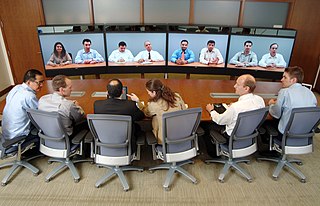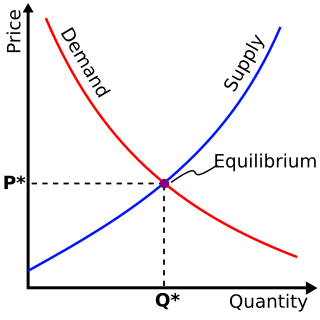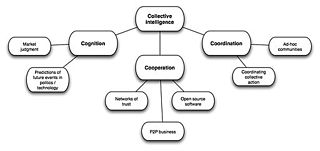Group models
Four group models are common in collaboration: [1]
- Chance
- Collaboration by chance is the most basic model and underlies all four. The team is a random pick of whoever is available without any specific regard for the skills or needs of each member.
- Acuity
- Collaboration by acuity establishes a team with balanced skill sets. The goal is to pick team members so each of the four acuities exist on the team. However, this does not mean a team of four is required as people can have varying levels of each acuity and even excel at more than one.
- Interest
- Collaboration by interest forms a team of persons with similar hobbies, curiosities or careers. Typically, this common interest is related to the problem the team plans to solve. While acuity is still important in this group, their common, unique knowledge may be able to overcome any weakness.
- Leader
- Collaboration by leader is a team model where the members are chosen by a leader. While the leader has common leadership qualities, those who assemble high performing teams also understand the process of collaboration. The goal is to pick team members with compatible values, schedules and working environments while also addressing interest and acuity.
Spence's basic rules
Spence identifies [1] seven rules for all collaboration:
- Look for common ground: find shared values, consider shared personal experiences, pay attention to and give feedback, be yourself and expect the same of others, be willing to accept differences in perception and opinions
- Learn about others: consider their perspectives and needs, appeal to the highest motives, let others express themselves freely
- Critique results, not people: do not waste time on personal hostility, make other people feel good, avoid criticism and put downs
- Give and get respect: show respect for others' opinions, be considerate and friendly, put yourself in the other person's shoes, be responsive to emotions, speak with confidence but remain tactful
- Proceed slowly: present one idea at a time, check for understanding and acceptance of each idea before moving on to the next. Speak in an organized and logical sequence.
- Be explicit and clear: share your ideas and feelings, pay attention to nonverbal communication, speak clearly and make eye contact, select words that have meaning for your listeners
- Remember the five "Cs" of communication: clarity, completeness, conciseness, concreteness, and correctness
Katzenbach and Smith's "team basics"
In research since 1993, Katzenbach and Smith have identified six fundamentals of collaboration that are necessary for high performing groups: [2]
- Small numbers of people—typically less than twelve
- Complementary skills in team members
- Common purposes for working
- Specific performance goals that are commonly agreed upon
- Shared working approaches
- Mutual accountability amongst all members
Working styles
Two primary types of working styles exist,[ citation needed ] each benefiting from contributions of the other:
- Alone/Quiet/Focused workers are typically self-paced, internal thinkers who are driven by goals and are conscious of ownership issues. They are usually best at expressing themselves in writing.
- Shared/High-Energy/Dynamic workers are typically fast-paced, external thinkers who are conceptual/visionary and work towards building consensus in real-time. They are usually best at expressing themselves verbally.
Conflict between these groups typically occurs when group one becomes passive aggressive or group two becomes outwardly aggressive. Managing expectations, building consensus and communicating well are ways to avoid conflict.
Acuity

While psychologist Howard Gardner identified seven major realms of intelligence,[ citation needed ] a more simple set of acuities may be more useful within smaller groups. Four roles have been identified and are defined as follows (note that individuals may score high in more than one category):
- The conceptualist role typically provides ideas, concepts and the 'visionary' direction of the group
- The formalist role typically excels at production tasks that relate to organization of content, adherence to formal requirements and quality of craft
- The operations role typically offers professional demeanor, documentation of process and articulation of verbal and/or visual presentation
- The technician role often excels at performing research and using technology
Higher performing teams often have a diverse set of skills and an appropriate number of persons in each role—as required by the goal of the team.
Thinking styles

There are two main components of thinking styles: internal and external,[ citation needed ] they share similarities to the extraversion and introversion traits seen in human personalities. The two thinking styles are dichotomies and can be used as axes when charting personal evaluation; note that "there is no 'right' place on the grid." [1]
Creation of ideas
Internal thinkers typically express themselves best through writing and take longer to develop and express ideas.
External thinkers typically express themselves best through speech and are faster at developing and expressing ideas.
Application of ideas
Detailed thinkers typically focus on specific, existing situations and start small, eventually working towards solving the greater whole of a given problem.
Visionary thinkers typically focus on broad, potential situations and start big, eventually working towards solving the more specific parts of a given problem
With both thinking styles, each benefits from the existence of the other; internal thinkers 'feed' off of the rapid-fire ideas of external thinkers and, conversely, external thinkers are 'grounded' by the deliberate pace at which internal thinkers operate (Note that the speed at which each functions has no correlation to intelligence). Detailed and visionary thinkers succeed in opposite realms and collaboratively can produce results faster and better than alone.
Learning styles

For collaboration purposes, three learning styles are typically identified:[ citation needed ]
- Auditory learning occurs through hearing the spoken word and represents approximately 25% of the population [1]
- Kinesthetic learning occurs through doing, touching and interacting and represents approximately 40% of the population [1]
- Visual learning occurs through images, demonstrations and body language and represents approximately 30% of the population [1]
Through the use of varied (or redundant) communication styles, collaborative groups can communicate better both internally and externally.
Agreeing upon group values is a step that "sets the tone" for further work. This is a convenient warm-up activity for a group and most commonly involves brainstorming a list and then picking a "top-ten." Spence recommends [1] that this is a high-priority item for the first meeting. Values may be grouped into categories, but each is up to debate:
- Healthy values and habits(Sensual and Operational Values) — Sensual values are individual values and are functional or dysfunctional to an individual's emotional survival. They are sensitive or insensitive depending upon an individual's emotional maturity. Operational values are individual values and are functional or dysfunctional to an individual's physical survival. They are active or inactive depending upon an individual's physical development. Healthy values and habits are acquired through personal satisfaction, practice and personal experience.
- Moral values and norms(Social and Religious/Traditional Values) — Social values are family/group values and are functional or dysfunctional to the survival of the family/group. They are nurturing or aggressive depending upon the family/group's social maturity. Religious/Traditional values are interpersonal values and are functional or dysfunctional to impersonal survival outside the family/group. They are tolerant or intolerant depending upon the religion's/tradition's maturity. Moral values are acquired through encouragement, instruction and interpersonal experience.
- Ethical values and behavior(Economic and Political Values) — Economic values are national values and are functional or dysfunctional to the survival of the nation. They are productive or unproductive depending upon the nation's economic development. Political values are national values and are functional or dysfunctional to national survival. They are progressive or regressive depending upon a nation's political development. Ethical values are acquired through rewards, education and impersonal experience.












